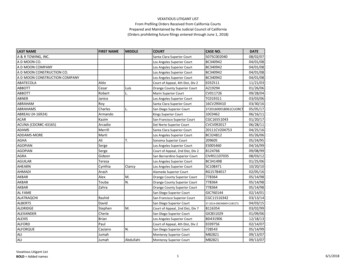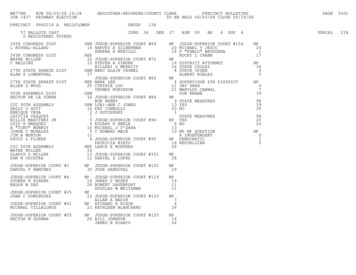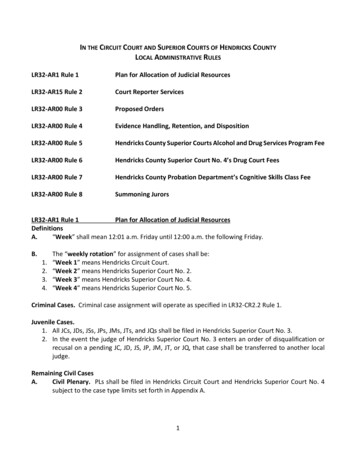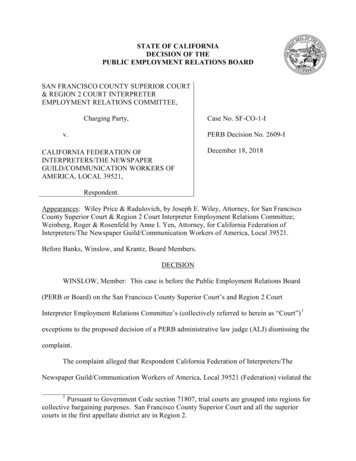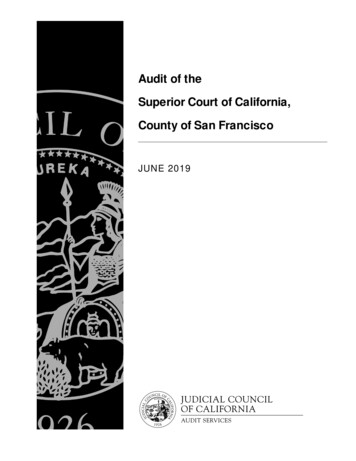
Transcription
Audit of theSuperior Court of California,County of San FranciscoJUNE 2019
This report contains confidential material for the sole use of the intended recipient(s). Anyreview, use, distribution, or disclosure to others is strictly prohibited until the audit report isaccepted by the Judicial Council.For authorization to distribute this report to any other parties please contact:Mr. Grant ParksPrincipal Manager, Audit ServicesJudicial Council of CaliforniaPhone:(916) 263-1321Fax:(415) 865-4337E-mail: Grant.Parks@jud.ca.gov
San Francisco Superior CourtJune 2019Superior Court of California, County of San FranciscoTable of ContentsEXECUTIVE SUMMARY . iBACKGROUND ON THE COURT’S OPERATIONS . ivAUDIT SCOPE AND METHODOLOGY . vSCHEDULE OF AUDIT FINDINGS AND PLANNED CORRECTIVE ACTION . 1CASH HANDLING . 2PROCUREMENT AND CONTRACTS . 16PAYMENT PROCESSING . 24FINE AND FEE DISTRIBUTIONS . 25ONE PERCENT FUND BALANCE CAP . 30JBSIS CASE FILING DATA . 31OTHER AREAS . 37
San Francisco Superior CourtJune 2019Page iEXECUTIVE SUMMARYIntroductionGovernment Code, sections 77206(g) and 77009(h) provide the Judicial Council of California(Judicial Council) with the authority to inspect and review superior court records and to performaudits, reviews, and investigations of superior court operations. The Judicial Council’s Office ofAudit Services (Audit Services) periodically conducts performance audits of the superior courtsin order to verify their compliance with the Judicial Council’s policies and with state law. Theseaudits, as well as similar audits of the appellate courts, are primarily focused on assisting thecourts identify which of their practices, if any, can be improved upon to better promote soundbusiness practices and to demonstrate accountability for their spending of the public’s funds.State law authorizes the Judicial Council to establish each superior court’s annual budget and toadopt rules for court administration, practice, and procedure. Most of the criteria used by AuditServices stems from the policies promulgated by the Judicial Council, such as those containedwithin the Trial Court Financial Policies and Procedures Manual (FIN Manual) and the JudicialBranch Contracting Manual (JBCM). These policies establish both mandatory requirements thatall superior courts must follow, as well as suggestive guidance. California’s courts drasticallyvary in terms of their caseloads, budget, and staffing levels, thus requiring the Judicial Council toadopt rules that at times provide the courts with flexibility given their varying resources andconstraints. State law also requires the superior courts to operate under a decentralized system ofmanagement, and the Judicial Council’s policies establish the boundaries within which courtsexercise their discretion when managing their day-to-day operations.Audit Services’ annual audit plan for the Judicial Branch establishes the scope of each audit andprovides a tentative schedule for the courts being audited during the fiscal year. The audit planexplains those scope areas deemed to be of higher risk based on Audit Services’ professionaljudgment and recognizes that other state audit agencies may, at times, perform reviews that mayoverlap with Audit Services work. In those instances, Audit Services may curtail its plannedprocedures as noted in the scope and methodology section of this report.Summary of Audit ResultsOur audit found that the Superior Court of California, County of San Francisco (Court)demonstrated compliance with many of the Judicial Council’s requirements evaluated during theaudit, and should be commended for its receptiveness to suggestions for further improvements.Table 1 below presents a summary of the audit’s results, including references to any auditfindings discussed in the body and a summary of the Court’s agreement or disagreement with thenoted findings. Other matters such as isolated or minor non-compliance—which in ourprofessional judgement do not rise to the level of a reportable finding—were communicatedseparately to the Court’s management in written form.
San Francisco Superior CourtJune 2019Page iiTable 1 Audit Results – At A Glance – California Superior Court, County of San FranciscoReportable Audit FindingsAreas and Sub-Areas Subject to ReviewTested# ofFindingsFindingReference(s)Court'sView2018-4-01; 02;03; 04Parti al l yagreesCash Handling1Daily Opening ProcessYes 2Voided TransactionsYes 3Handwritten ReceiptsYes 4Mail PaymentsYes45Internet PaymentsYes 6Change FundYes12018-6-01Agrees7End-Of-Day Balancing and CloseoutYes22018-7-01; 02Agrees8Bank DepositsYes12018-8-01Agrees9Other Internal ControlsYes 10Procurement InitiationYes12018-10-01Parti al l yagrees11Authorization & Authority LevelsYes 12Competitive ProcurementsYes12018-12-01Agrees13Non-Competitive ProcurementsYes 14Leveraged Purchase AgreementsYes 15Contract TermsYes 16Other Internal ControlsYes12018-16-01Agrees173-Point Match ProcessYes 18Payment Approval & Authority LevelsYes 19Special Rules - In-Court Service ProvidersYes 20Special Rules - Court InterpretersN/A-21Other Items of ExpenseYes 22Jury ExpensesYes 23Allowable CostsYes 24Other Internal ControlsYes 2018-25-01Agrees2018-29-01; 02AgreesProcurement and ContractsPayment ProcessingFine & Fee Distribution25CMS-Calculated DistributionsYes126Manually-Calculated DistributionsN/A-1% Fund Balance Cap27Calculation of the 1% CapYes 28Use of "Held on Behalf" FundsYes Validity of JBSIS DataYes2[None]N/A-JBSIS Case Filing Data29Other Areas30Source:Auditor generated table based on testing results and court management's perspective.Note:Areas subjected to testing are generally based on requirements in the Trial Court Financial Policies and Procedures Manual, theJudicial Branch Contracting Manual, or California Rules of Court, but may also include other Judicial Council policies and directives.Areas not tested are based on audit determinations—such as area not applicable, recently reviewed by others, or no transactionsselected to review—which are described more fully in the Audit Scope and Methodology section of the report. Applicable criteria arecited in each audit finding (as referenced above) in the body of our report. The Judicial Council's audit staff determine the scope ofeach audit based on their professional judgment and the needs of the Judicial Council, while also providing the Court with anopportunity to highlight additional areas for potential review depending on available audit resources.
San Francisco Superior CourtJune 2019Page iiiThe Court demonstrated consistent adherence to several different compliance requirementsevaluated during the audit, as shown in Table 1. In particular, the Court generally demonstratedstrong compliance in the area of payment processing. For example, our review of the Court’spayment processing practices found that it demonstrated sound management practices in theareas of payment approval and authority levels, in paying in-court service providers, and inensuring the Court pays for only allowable costs.Nonetheless, our audit did identify 14 reportable audit findings where we believe the Courtshould consider taking corrective action to improve its operations and more fully comply withthe Judicial Council’s policies. These 14 findings are identified in Table 1 under the column“Reportable Findings” and include reference numbers indicating where the reader can view infurther detail the specific findings and the Court’s perspective.One particular area of focus for the Court as it considers opportunities for improvement shouldinclude strengthening its controls over the payments it receives in the mail. Specifically, theCourt did not use a payment receipts log to record and track the payments received in the mailand did not restrictively endorse checks or other negotiable instruments received in the mailimmediately upon receipt. Without a mail payments receipt log, the Court has no record toreference or research should a mail payment become lost or stolen. Furthermore, notimmediately endorsing and not securing unprocessed mail payments heightens the risk of theft orloss of these payments. The Court indicated that it agrees that completing a payment receipts logis the best approach but may have difficulty implementing such a control due to limited staffing,so it will explore the use of other mitigating controls. The Court also indicated that it wouldimplement a process to immediately endorse all check and money orders received by staff.The Court should also focus on ensuring that its procurement process begins with an approvedpurchase requisition form. The Court does not always use and document written purchaserequisitions to demonstrate that an authorized individual approved the purchase request beforecommencement of the solicitation or vendor selection. When the Court does not have a practiceof using written purchase requisitions to document its purchase requests and authorizations, itrisks staff initiating and making purchases without the oversight of management, potentiallyresulting in procurements that may be either inappropriate or not in the Court’s best interests.The Court indicated that moving forward, it would update its purchasing procedures to requiredocumentation indicating manager approval of purchase requests.Summary Perspective of Court OfficialsAudit Services initiated its audit of the Court on March 13, 2019, and completed fieldwork onApril 19, 2019. Audit Services shared the draft audit findings with the Court’s officials on May15, 2019, and received the Court’s final official responses on June 17, 2019. The Court generallyagreed with the findings and its specific responses for each are included in the body of the report.
San Francisco Superior CourtJune 2019Page ivBACKGROUND ON THE COURT’S OPERATIONSThe Superior Court of California, County of San Francisco (Court) operates four court facilitiesin the city of San Francisco. The Court operates under the authority and direction of thePresiding Judge, who is responsible for ensuring the effective management and administration ofthe Court, consistent with any rules, policies, strategic plan, and the funding provided by theJudicial Council.California’s 58 superior courts each have differing workloads, staffing levels, and financialresources. They operate under a decentralized system of governance and are each responsible fortheir own local court operations and business decisions. The Presiding Judge has the authority to:develop a local budget and allocate the funding provided by the Judicial Council; approveprocurements and contracts; and authorize the Court’s expenditures. The information in Table 2is intended to provide the reader with context and perspective on the Court’s relative size andworkload compared to averages of all 58 superior courts.Table 2 – Statistical Data for San Francisco Superior Court and Average of all Superior CourtsStatisticFinancial Highlights (Fiscal Year 2017-18)Total RevenueTotal ExpendituresStaff Salaries & BenefitsAs a % of Total ExpendituresJudicial Officers and Staff(2018 Court Statistics Report)JudgesCommissioners/RefereesNon-Judicial Staff (approx.)TotalSan FranciscoSuperiorCourtAverage of All Superior CourtsCluster 2Cluster 3Cluster 4CourtsCourtsCourtsCluster 1CourtsAll 58 Courts 73,239,549 75,558,858 2,203,7812,238,710 10,614,170 10,747,319 41,408,761 41,941,660 194,435,516 198,103,021 43,334,366 44,073,255 57,774,49176.5% 1,498,58166.9% 32,278,73777.0% 159,856,12680.7% ew Case Filings (Fiscal Year 2016-17)Appeal FilingsCivil FilingsCivilFamily LawJuvenile DelinquencyJuvenile DependencyMental HealthProbateSmall ClaimsCriminal FilingsFeloniesMisdemeanors / inancial and case filings data maintained by the Judicial Council. The date ranges differ for the above information due to thedifferent sources of data. The financial data is from the Judicial Council's Phoenix financial system, the judicial officer and staffcounts information is from the most recent Court Statistics Report, and the case filing counts are from the Judicial Branch StatisticalInformation System data as of April 2, 2019, and may not agree with other reports as this data is subject to continuous updates.Note:The Judicial Council generally groups superior courts into four clusters and uses these clusters, for example, when analyzingworkload and allocating funding to courts. According to past Judicial Council documents, the cluster 1 courts are those superiorcourts with between 1.1 and 4 judicial position equivalents (JPEs), cluster 2 courts are those with between 4.1 and 20 JPEs, cluster 3courts are those with between 20.1 and 59.9 JPEs, and cluster 4 courts are those with 60 or more JPEs. San Francisco Superior Courtis a cluster 4 court.
San Francisco Superior CourtJune 2019Page vAUDIT SCOPE AND METHODOLOGYAudit Services initiated an audit of the Superior Court of California, County of San Francisco(Court) in order to determine whether it complied with certain key provisions of statute and thepolicies and procedures adopted by the Judicial Council of California. Our audit was limited toevaluating compliance with those requirements that, in our professional judgment, werenecessary to answer the audit’s objectives. The period covered by this audit was generallylimited to fiscal year 2018-19, but certain compliance areas noted below required that we reviewearlier periods or current practices. Table 3 lists the specific audit objectives and the methods weused to address them.Table 3 – Audit Objectives and the Methods Used to Address Them123Audit ObjectiveThrough inquiry, auditor observation,and review of local court policies andprocedures, identify areas of high riskto evaluate the Court’s compliance.MethodAudit Services developed an annual audit plangenerally identifying areas of high risk at thesuperior courts. At the Court, we made inquiriesand reviewed any local procedures to furtherunderstand its unique processes in eachcompliance area.Determine whether the Courtimplemented adequate internalcontrols over its handling of cashreceipts and other payments. Such areview will include, at a minimum,the following:We obtained information from the Courtregarding the types and average volume ofcollections at each of its payment collectionlocations. For selected locations, we observed theCourt’s practice for safeguarding and accountingfor cash and other forms of payments from thepublic. For example, we reviewed and observedthe Court’s practice for appropriately segregatingincompatible duties, assigning cash drawers tocashiers at the beginning of the day, reviewingand approving void transactions, safeguardingand accounting for handwritten receipts, openingand processing mail payments, controlling accessto change funds, overseeing the end-of-daybalancing and closeout process, and preparingand accounting for the daily bank deposits. Determine whether the Courtcomplied with the mandatoryrequirements in the FINManual for internal controlsover cash (payment) handling. Assess the quality of theCourt’s internal controls tominimize the potential fortheft, such as controls over theuse of manual receipts andvoided transactions.Determine whether the Courtdemonstrated appropriate control overits non-personal services spendingactivities. Specifically, our reviewincluded the following:We reviewed the Court’s assignment ofpurchasing and payment roles to assess whether itappropriately segregated staff roles for approvingpurchases, procuring the goods or services,
San Francisco Superior CourtJune 2019Page vireceiving the goods, and paying for the goods orservices. Determine whether the Court’s We judgmentally selected a sample of 25procurement transactionsexpenditure transactions and assessed whethercomplied with the applicableeach transaction’s underlying procurement:requirements in the JudicialBranch Contracting Manual or Was properly reviewed and approved bythe Trial Court Financialauthorized court management.Policies and ProceduresManual. Adhered to competitive biddingrequirements, when applicable. 4Determine whether the Court’spayment transactions–including but not limited tovendor payments and claimpayments–were reasonableand in compliance with theTrial Court Financial Policiesand Procedures Manual andapplicable Judicial Councilpolicies and rules.Had contracts, when applicable, thatcontained certain terms required to protectthe Court’s interests.We judgmentally selected a sample of 40payments pertaining to various purchase orders,contracts, or in-court services, and determinedwhether: The Court followed the 3-point matchprocess as described in the FIN Manual toensure goods and services are receivedand accepted, and in accordance withcontract terms prior to payment. Appropriate court staff authorizedpayment based on the Court’s paymentcontrols and authorization matrix. Whether the payment reasonablyrepresented an allowable “courtoperations” cost per Rule of Court, Rule10.810. Whether the payments for in-court serviceproviders adhered to applicable JudicialCouncil policies.Determine whether the Court properly We reviewed the Court’s process for updatingcalculates fine and fee distributionsand controlling access to its distribution tables.for certain selected code violations.
San Francisco Superior CourtJune 2019Page viiWe also reviewed the Court’s calculations anddistributions of fines, penalties, fees, andassessments for certain high volume or complexcode violations.56Determine whether the Court properlycalculates its one percent fund balancecap for the most recent completedfiscal year.We obtained the Court’s final 1% Fund BalanceCap Calculation Form for the most recentlycompleted fiscal year at the time of our testing(fiscal year 2017-18), and performed thefollowing: Verified significant calculations andbalance amounts. Traced and verified significant inputs onthe form (such as year-end encumbrances)to supporting records and the Phoenixaccounting system.Determine whether the Court spentany funds the Judicial Councilapproved the Court to hold from prioryear excess fund balance funds onlyfor the purposes approved by theJudicial Council.We obtained any Judicial Council-approvedrequests by the Court to hold excess prior yearfund balances. To the extent that the Court hadand spent any of these held funds, we verifiedthat such spending was limited for the purposespreviously approved by the Judicial Council.Determine whether the Courtaccurately reports case filings data tothe Judicial Council through theJudicial Branch Statistics InformationSystem (JBSIS).We obtained an understanding of the Court’sprocess for reporting case filings data to theJudicial Council through JBSIS. For the mostrecent fiscal year for which the Judicial Councilfroze and used JBSIS data for funding allocations(fiscal year 2016-17), we performed thefollowing: Obtained the relevant JBSIS case filingsdata the Court reported to the JudicialCouncil and reconciled the case filingscounts it reported to its underlying recordsof cases supporting each reported casefiling count, by case type, to validate thatthe Court accurately reported its casefilings count data. We selected 10 cases from six case types,for a total of 60 reported cases, and
San Francisco Superior CourtJune 2019Page viiireviewed the relevant case file records toverify that the Court correctly applied theJBSIS definitions for reporting each casefiling.Assessment of Data ReliabilityThe U.S. Government Accountability Office (GAO) requires us to assess the sufficiency andappropriateness of computer-processed information that we use to support our findings,conclusions, or recommendations. In performing this audit, we obtained and reviewed financialtransaction data from the Phoenix financial system—the statewide accounting system used by thesuperior courts—for the limited purpose of selecting transactions to test the Court’s compliancewith its procurement and related payment activities. Prior to making our selections, weindependently queried the Phoenix financial system to isolate distinct types of non-personalservice expenditure transactions relevant to our testing—such as by general ledger code—andreconciled the resulting extract with the Court’s total expenditures as noted on its trial balancereport for the same period. Our analysis noted no material differences leading us to conclude thatuse of the Phoenix financial transaction data was sufficiently reliable for the limited purpose ofselecting transactions for testing.Report DistributionThe Judicial Council’s Advisory Committee on Audits and Financial Accountability for theJudicial Branch reviewed this report on June 28, 2019, and approved it for public release.California Rules of Court, Rule 10.500 provides for the public access to non-deliberative or nonadjudicative court records. Final audit reports are among the judicial administrative records thatare subject to public access unless an exemption from disclosure is applicable. The exemptionsunder rule 10.500 (f) include records whose disclosure would compromise the security of ajudicial branch entity or the safety of judicial branch personnel. As a result, any informationmeeting the nondisclosure requirements of rule 10.500(f) have been omitted from this auditreport.Audit StaffThis audit was completed by the following staff under the general supervision of Robert Cabral,Manager:Dawn Tomita, Audit SupervisorJoe Meyer, Senior Auditor (auditor-in-charge), CPA, CIAMaria Dooley, Auditor, CPA, CFEKurtis Nakamura, AuditorMichelle O’Connor, Auditor, CPA
San Francisco Superior CourtJune 2019Page 1SCHEDULE OF AUDIT FINDINGS AND PLANNED CORRECTIVE ACTION
San Francisco Superior CourtJune 2019Page 2CASH HANDLINGThe Court Generally Followed Required Cash Handling Procedures, But Can StrengthenIts Controls Over Certain Payment Collection ProcessesBackgroundTrial courts must collect and process customer payments in a manner that protects the integrityof the court and its employees, and promotes public confidence. Thus, trial courts shouldinstitute a system of internal control procedures that assure the safe and secure collection, andaccurate accounting of all payments. A court’s handling of collections is inherently a high-riskactivity given the potential incentives for court employees to act inappropriately when mandatoryinternal controls per the Trial Court Financial Policies and Procedures Manual (FIN Manual) arecompromised or not in operation.Overall, the Court demonstrated compliance in many of the cash handling areas we evaluatedduring the audit. Specifically, the Court demonstrated sound management practices in the areasof its voided transactions, handwritten receipts, and internet payments. Nevertheless, weidentified eight audit findings that we believe require the Court’s attention and corrective action.These findings pertained to the following specific areas of cash handling:Finding 6-012018-7-012018-7-022018-8-01Subject AreaMail Payments – Mail Opening ProcessMail Payments – EndorsementMail Payments – Receipts LogMail Payments – Safeguarding Unprocessed MailPaymentsChange Fund – AccountabilityEnd-of-Day Balancing and Closeout – Blind CloseoutEnd-of-Day Balancing and Closeout – VerificationBank Deposits – Deposit VerificationFINDING REFERENCE: 2018-4-01MAIL PAYMENTS – MAIL OPENING PROCESSCRITERIAFIN MANUAL, FIN 10.02, 6.4 PAYMENTS RECEIVED THROUGH THE MAIL:2. To provide for the strongest protection of trial court assets and to protect the integrity andreputation of the trial court, a team approach should be used to maintain accountability forpayments received through the mail. When processing mail payments, the court shouldadhere to the following procedures:a. One person can open the mail and create the payment receipts log if he or she is recordedon video and the video is retained for at least six months.
San Francisco Superior CourtJune 2019Page 3b. Mail should only be processed when both team members are present. Alternatively, iftwo people cannot be present during mail opening, then one person—without opening theenvelopes—should start the payment receipts log by sequentially numbering theenvelopes and documenting the envelope number and the sender’s name in the paymentreceipts log. When the second person opens the mail, he or she should complete thepayment receipts log for each envelope identified by the first person. A field should beadded to the payment receipts log to indicate when an envelope does not contain apayment; not all fields listed in Paragraph 3(b) below will be completed.c. Two-person team combinations should be rotated regularly.d. To maintain separation of duties, team members opening and logging mail paymentsshould not also enter the mail payments in the court’s cashiering system and/orautomated case management system, if possible.FIN MANUAL, FIN 1.01, 6.4 TRIAL COURT OPERATING STANDARDS:4. A presiding judge or his/her designee who wants to establish an alternative procedure willsubmit a signed and dated Request for Alternative Procedure Form (copy provided in 7.0,Associated Documents) to:Judicial Council of CaliforniaDirector of Branch Accounting and ProcurementAttn.: Trial Court Alternative Financial Policies and Procedures2850 Gateway Oaks Drive, Suite 300Sacramento, CA 95833-4348E-mail: TCFin@jud.ca.govA written response to the submission of alternative procedures will be returned to thesubmitting court within 60 business days of receipt of the document. When a Request forAlternative Procedure has been received by Judicial Council of California Staff, anacknowledgement of receipt will be returned to the submitting court. The 60 business-dayresponse time will begin once the court receives that acknowledgement of receipt. Absent aresponse from Judicial Council of California Staff within 60 business-days, the alternativeprocedure will be in effect, subject to further review and consideration by Judicial Council ofCalifornia Staff. Undocumented procedures or those not approved by Judicial Council ofCalifornia Staff will not be considered valid for audit purposes.Once approved, alternative procedures must be documented by the trial court, incorporatedinto the local trial court manual, and distributed to court personnel. Any alternative procedurethat is different from what is included in the Trial Court Financial Policies and ProceduresManual or the county’s policy document must first be approved by Judicial Council ofCalifornia Staff.CONDITIONThe Civic Center Courthouse (CCC) and the Hall of Justice (HOJ) payment collection locationsdo not follow the suggested two-person “team approach” when opening payments receivedthrough the mail. In addition, the Civil Division at CCC and the mail clerk at HOJ do not adhereto an alternative procedure, such as opening the mail in an open area visible to others or in frontof a camera, to mitigate the risk of lost or stolen mail payments. Specifically, at the Civil
San Francisco Superior CourtJune 2019Page 4Division, the clerk opens all non-Civil Division mail alone in a mailroom. While this mailroomdoes have a large window wall, the window wall faces another solid wall, making clear oversightover the clerk’s opening of the mail, which at times contains payments, unlikely or difficult atbest. At HOJ, the clerk in charge of distributing the mail to the Collections division may openmail containing a payment if the envelope is not properly addressed. Specifically, the clerkcollects the mail from the mailroom, sorts it, and distributes it to various units. The clerkperforms this sorting alone and in a cubicle with higher walls. Typically, this clerk will distributethe mail, unopened, to the appropriate party. However, if the envelope is not addressed to aspecific unit, the clerk may need to open the envelope to figure out which unit the mail is meantfor, and the mail could include a payment. According to the Court, it does not have a sufficientnumber of available staff to assign two people to open the mail. However, when courts do notuse two-person teams to open mail nor implement alternative procedures such as those suggestedin the FIN Manual, they are at heightened risk for lost or stolen mail payments. Paymentsreceived by mail is an area of high-risk–since the payer is neither present during the transactionnor is guaranteed to receive a receipt–and the FIN Manual’s guidance is intended to mitigate therisk of lost or stolen payments.Additionally, at the CCC and HOJ payment collection locations, the Court allows staff who openthe mail payments and drop box payments to also enter those payments in
Table 2 - Statistical Data for San Francisco Superior Court and Average of all Superior Courts . Cluster 1 Courts Cluster 2 Courts Cluster 3 Courts Cluster 4 Courts All 58 Courts Financial Highlights (Fiscal Year 2017-18) Total Revenue 73,239,549 2,203,781 10,614,170 41,408,761 194,435,516 43,334,366


